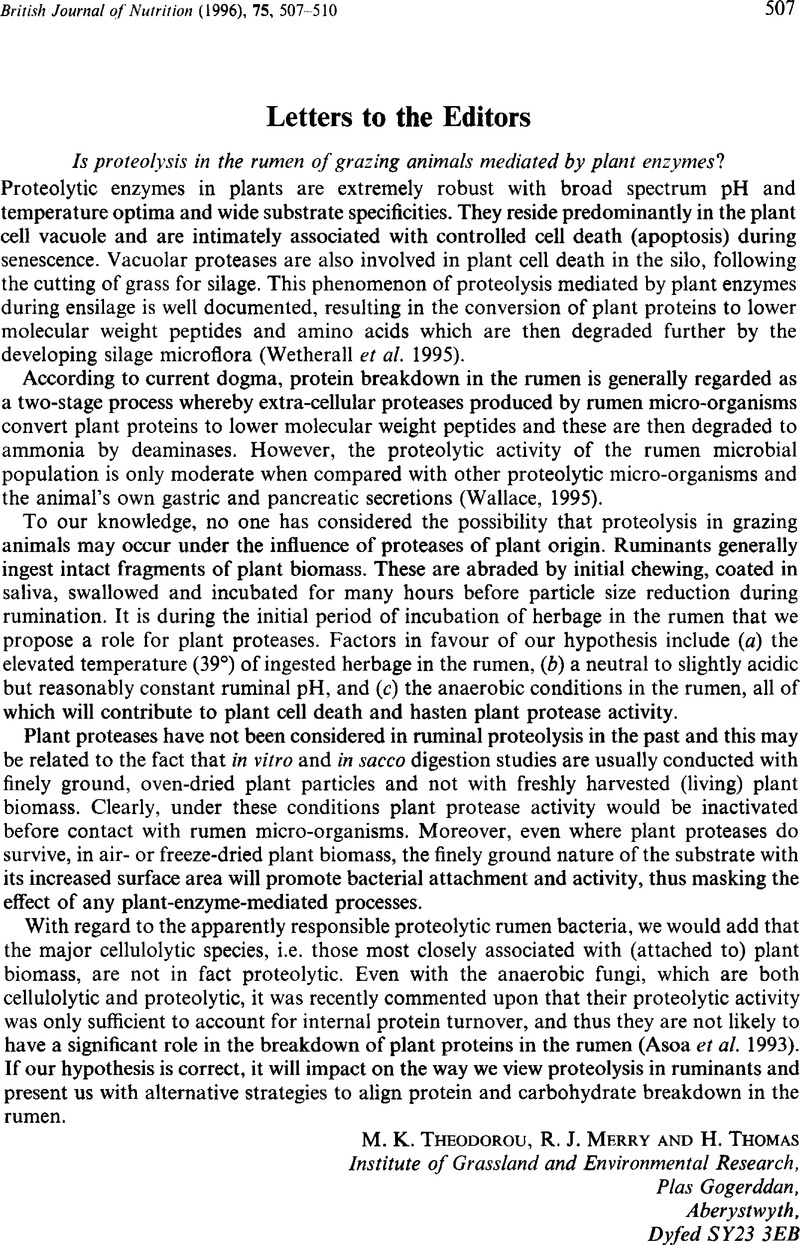Crossref Citations
This article has been cited by the following publications. This list is generated based on data provided by Crossref.
Theodorou, Michael K.
Mennim, Georgina
Davies, David R.
Zhu, Wei-Yun
Trinci, Anthony P. J.
and
Brookman, Jayne L.
1996.
Anaerobic fungi in the digestive tract of mammalian herbivores and their potential for exploitation.
Proceedings of the Nutrition Society,
Vol. 55,
Issue. 3,
p.
913.
McSweeney, C.S
Dalrymple, B.P
Gobius, K.S
Kennedy, P.M
Krause, D.O
Mackie, R.I
and
Xue, G.P
1999.
The application of rumen biotechnology to improve the nutritive value of fibrous feedstuffs: pre- and post-ingestion.
Livestock Production Science,
Vol. 59,
Issue. 2-3,
p.
265.
Zhu, W.-Y.
Kingston-Smith, A.H.
Troncoso, D.
Merry, R.J.
Davies, D.R.
Pichard, G.
Thomas, H.
and
Theodorou, M.K.
1999.
Evidence of a Role for Plant Proteases in the Degradation of Herbage Proteins in the Rumen of Grazing Cattle.
Journal of Dairy Science,
Vol. 82,
Issue. 12,
p.
2651.
Wallace, R.J.
Wallace, S.J.A.
and
McKain, N.
2000.
Proteolytic activity of ruminal digesta during the feeding cycle in sheep receiving grass hay/concentrate or maize silage/concentrate diets.
Letters in Applied Microbiology,
Vol. 30,
Issue. 4,
p.
317.
Wallace, R. J.
Wallace, S. J. A.
and
McKain, N.
2000.
An assessment of the contribution of plant proteinases to proteolytic digestion in the rumen of sheep.
Proceedings of the British Society of Animal Science,
Vol. 2000,
Issue. ,
p.
5.
Beha, E. M.
Theodorou, M. K.
Thomas, B. J.
and
Kingston‐Smith, A. H.
2002.
Grass cells ingested by ruminants undergo autolysis which differs from senescence: implications for grass breeding targets and livestock production.
Plant, Cell & Environment,
Vol. 25,
Issue. 10,
p.
1299.
KINGSTON‐SMITH, A H
and
THOMAS, H M
2003.
Strategies of plant breeding for improved rumen function.
Annals of Applied Biology,
Vol. 142,
Issue. 1,
p.
13.
Kingston‐Smith, Alison H.
Bollard, Andrea L.
Thomas, Barry J.
Brooks, Alison E.
and
Theodorou, Michael K.
2003.
Nutrient availability during the early stages of colonization of fresh forage by rumen micro‐organisms.
New Phytologist,
Vol. 158,
Issue. 1,
p.
119.
Kingston-Smith, A. H.
Merry, R. J.
Leemans, D. K.
Thomas, H.
and
Theodorou, M. K.
2005.
Evidence in support of a role for plant-mediated proteolysis in the rumens of grazing animals.
British Journal of Nutrition,
Vol. 93,
Issue. 1,
p.
73.
Attwood, G. T.
2005.
The contribution of plant-derived proteinases to the breakdown of fresh pasture protein in the rumen.
British Journal of Nutrition,
Vol. 93,
Issue. 4,
p.
421.
Kingston-Smith, Alison H.
Davies, Teri E.
Edwards, Joan E.
and
Theodorou, Michael K.
2008.
From plants to animals; the role of plant cell death in ruminant herbivores.
Journal of Experimental Botany,
Vol. 59,
Issue. 3,
p.
521.
Gierus, Martin
Loesche, Marc
Salama, Heba
Herrmann, Antje
and
Taube, Friedhelm
2016.
Protein degradation rate as affected by plant proteases among fresh samples of perennial ryegrass cultivars (Lolium perenne L.) / Einfluss pflanzlicher Proteasen auf den Proteinabbau bei unterschiedlichen Englischen Raigrass Sorten (Lolium perenne L.).
Die Bodenkultur: Journal of Land Management, Food and Environment,
Vol. 67,
Issue. 2,
p.
61.



